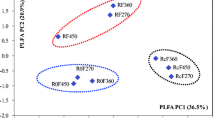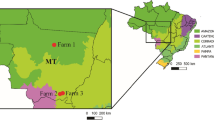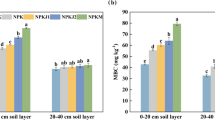Abstract
A case study on the nutrient input-output budget of slash and burn agriculture was carried out in Northeast-Pará, Brazil, where such a land-use system has been practised for about 100 years. A common cropping period lasts for two years and the fields lie fallow for 4 to 8 years. We quantified rates of deposition, fertilization, and losses due to the burn, harvest and leaching. Six fields of different phases in the rotational cycle were under study during a 19 month period. During the fallow period, the input of Na, K, Mg, N, P and S via deposition exceeded the estimated losses with the seepage water. The Ca budget was almost balanced. The balance of fields in the transition from the fallow to the cropping phase was negative for Na, K, Ca, Mg, N, and S. The P balance was positive when NPK fertilizer was applied, and negative without fertilizer application. The nutrient balance for K, Mg, Ca, N, and P was also negative on the field in transition from the cropping to the fallow period. The nutrient budget for an entire land-use cycle of 9 years was estimated by the “false time series approach”. In the case of an NPK fertilization during the cropping period there were net losses of 75 kg K ha−1, 125 kg Ca ha−1, 16 kg Mg ha−1, 285 kg N ha−1 and 13 kg S ha−1. Na (86 kg ha−1) and P (11 kg ha−1) were accumulated. The harvest was the most important flux for the K (61%) and P (62%) output. The element transfer into the atmosphere during the burn caused the main losses of N (60%), S (65%), Ca (58%) and Mg (41%). The most important path of Na loss was leaching (92%). The net K losses were severe as they represented 45% of the K store found extractable in the soil down to 1m depth and in the above ground biomass. The presented results may be useful in planning a sustainable and environmentally protective method of land-use within a shifting cultivation system. It is strongly recommended that slash burning be abandoned in order to keep the nutrients in the ecosystem.
Similar content being viewed by others
References
Andriesse JP and Schelhaas RM (1987) A monitoring study on nutrient cycles in soils used for shifting cultivation under various climatic conditions in tropical Asia. III. The effects of land clearing through burning on fertility level. Agric. Ecosys. Environ. 19: 311–332.
Brinkmann WLF and de Nascimento JC (1973) The effect of slash and burn agriculture on plant nutrients in the Tertiary region of Central Amazonia. Turrialba 23 (3): 284–290.
Bruijnzeel LA (1983) Hydrological and biogeochemical aspects of man-made forests in south- central Java, Indonesia. PhD dissertation, Vrije Universiteit Amsterdam.
Cerri CC, Volkoff B and Andreaux F (1991) Nature and behavior of organic matter in soils under natural forest, and after deforestation, burning and cultivation, near Manaus. For. Ecol. Manage. 38: 247–257.
Clausing G (1994) Frühe Regeneration und Wiederbesiedlung auf Kulturflächen der Wald- Feld-Wechselwirtschaft im östlichen Amazonasgebiet. Göttinger Beiträge zur Land- und Forstwirtschaft in den Tropen und Subtropen 97, 151 pp.
Denich M (1989) Untersuchungen zur Bedeutung junger Sekundärvegetation für die Nutzungssystemproduktivität im östlichen Amazonasgebiet, Brasilien. Göttinger Beiträge zur Land- und Forstwirtschaft in den Tropen und Subtropen 46, 265 pp.
Denich M and Kanashiro M (1995) Secondary vegetation in the agricultural landscape of North-Eastern Para, Brazil. In: Parrotta JA and Kanashiro m (eds) Management and rehabilitation of degraded lands and secondary forests in Amazonia. International Institute of Tropical Forestry, Rio Piedras, Puerto Rico, pp 12–21.
Fearnside PM (1996) Amazonian deforestation and global warming: carbon stocks in vegetation replacing Brazil's Amazon forest. For. Ecol. Manage. 80: 21–34.
Feigl BJ, Melillo J and Cerri CC (1995) Changes in the origin and quality of soil organic matter after pasture introduction in Rondônia (Brazil). Plant and Soil 175: 21–29.
Haase H and Fölster H (1982) Bioelement inventory of a tropical (semi) evergreen seasonal forest on eutrophic alluvial soils in West Venezuela. Oecol. Plant. 17: 331–346.
Hodnett MG, Pimental da Silva L, da Rocha HR and Senna RC (1995) Seasonal soil water storage changes beneath central Amazonian rainforest and pasture. J Hydrol. 170: 233–254.
Hölscher D (1995) Wasser- und Stoffhaushalt eines Agrarökosystems mit Waldbrache im östlichen Amazonasgebiet. Göttinger Beiträge zur Land- und Forstwirtschaft in den Tropen und Subtropen 106, 134 pp.
Hölscher D, de Abreu Sá TD, Bastos TX, Denich M and Fölster H (1997) Evaporation from young secondary vegetation in Eastern Amazonia. J. Hydrol. (in press).
IDESP (1990) Anuário Estatistico do Estado do Pará 1990. Instituto do Desenvolvimento Econômico e Social do Pará, Vol. 11 - Tomo 1.
Jordan CF (1985) Soils of the Amazon Rainforest.In: Key environments: Amazonia. 83–94, Pergamon Press, Oxford.
Jordan, CF (ed) (1987) Amazonian rain forests. Ecosystem disturbance and recovery. Springer, New York.
Kühne RF (1993) Wasser- und Nährstoffhaushalt in Mais-Maniok-Anbausystemen mit und ohne Integration von Alleekulturen (“Alley cropping”) in Süd-Benin. Hohenheimer Bodenkundliche Hefte 13: 244pp.
Mackensen, J (1994) Nährstoffverluste in die Atmosphäre beim Verbrennen von Schlagabraum in Ost-Amazonien. Diploma thesis, University of Göttingen, Germany: 88 pp.
Mackensen J, Hölscher D, Klinge R and Fölster H (1996) Nutrient transfer to the atmosphere due to burning of debris in East-Amazonia. For. Ecol. Manage. 86: 121–128.
Martins SP, Cerri CC, Volkoff B, Andreaux F and Chauvel A (1991) Consequences of clearing and tillage on the soil of a natural Amazonian ecosystem. For. Ecol. Manage. 38: 273–281.
Nepstad DC, de Carvalho CR, Davidson EA, Jipp PH, Lefebvre PA, Negreiros GH, da Silva ED, Stone TA, Trumbore SE and Vieira S (1994) The role of deep roots in the hydrological and carbon cycles of Amazonian forests and pastures. Nature 372(15): 666–669.
Neill C, Picollo MC, Steudler PA, Melillo JM, Feigl BJ and Cerri CC (1995) Nitrogen dynamics in soils of forests and active pastures in the Western Brazilian Amazon basin. Soil Biol. Biochem. 27(9): 1167–1175.
Poss R and Saragoni H (1992) Leaching of nitrate, calcium and magnesium under maize cultivation on an oxisol in Togo. Fert. Res. 33: 123–133.
Russel CE (1983) Nutrient cycling and productivity of native and plantation forests at Jari Florestal, Pará, Brazil. PhD thesis, University of Georgia, 133 pp.
Scott GAJ (1987) Shifting cultivation where land is limited. Campa indian agriculture in the Gran Pajonal of Peru. In: Jordan CF (ed) Amazonian rain forests. Ecosystem disturbance and recovery, 34–45, Springer New York.
Sommer R (1996) Kohlenstoffvorräte in Böden unter intensiv genutzten Sekundärwaldflächen im östlichen Amazonasgebiet. Diploma thesis, University of Göttingen, Germany: 122 pp.
Spangenberg A, Grimm U, da Silva JRS, and Fölster H (1996) Nutrient store and export rates of Eucalyptus urograndis plantations in Eastern Amazonia (Jari). For. Ecol. Manage. 80: 225–234.
Stromgaard P (1984) The immediate effect of burning and ash-fertilization. Plant and Soil 80: 307–320.
Uhl C, Jordan CF, Clark K and Herrera R (1982) Ecosystem recovery in Amazon caatinga forest after cutting, cutting and burning, and bulldozer clearing treatments. Oikos 38: 313–320.
Uhl C and Jordan CF (1984) Succession and nutrient dynamics following forest cutting and burning in Amazonia. Ecol. 65(5): 1476–1490.
Watrin OS (1994) Estuda da dinâmica na paisagem da Amazô⊁a Oriental através de técnicas de geoprocessamento. M.Sc. Thesis, Instituto Nacional de Pesquisas Espaciais (INPE), Sao José dos Campos — São Pulo: 153pp
Author information
Authors and Affiliations
Rights and permissions
About this article
Cite this article
Hölscher, D., Möller, R.F., Denich, M. et al. Nutrient input-output budget of shifting agriculture in Eastern Amazonia. Nutr Cycl Agroecosyst 47, 49–57 (1996). https://doi.org/10.1007/BF01985718
Received:
Accepted:
Issue Date:
DOI: https://doi.org/10.1007/BF01985718




